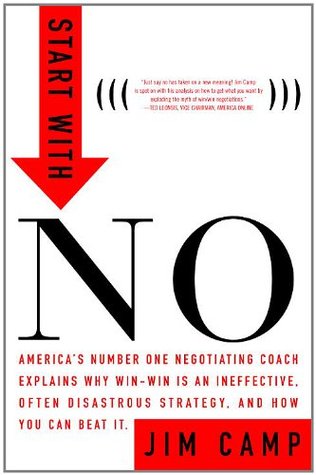More on this book
Community
Kindle Notes & Highlights
by
Jim Camp
Started reading
August 26, 2019
Or search your pocket for your notepad and come up short and ask to borrow a slip of paper. Or pretend your Palm Pilot has run out of power—again. And then try to tell me you don’t notice an immediate, beneficial difference in the atmosphere of this “negotiation.”
How Decisions Move Negotiations Forward
In Japan, where negotiation is revered almost as a cultural art form, it is said that we should make all of our decisions with the stomach—hara—never with the head or with the heart. I absolutely agree that this is where decisions start. This is the way we do make decisions, whether we like the idea or not.
In a negotiation, decisions are 100 percent emotional. Yes, 100 percent. Research psychologists have proved this beyond any doubt. Sometimes we use the term “negotiation science,” but the “science” part is knowing that decisions themselves are all emotion.
it is always gut-check time, because ...
This highlight has been truncated due to consecutive passage length restrictions.
When we watch ourselves and other people carefully, we can actually see the transition from the emotional state—the hara—to the intellectual state—the head. Every day, every hour, even every minute, under some circumstances, we flip back and forth between the emotional and the so-called rational. Our emotions rage all over the scale before we make a decision, and then we set about rationalizing it. Successful negotiation requires the complete understanding and application of this dynamic of decision making.
My system sees emotions for what they are and works with them, not against them. My system teaches us how to progress from emotions, which never produce deals that stick, to decisions that do produce deals that stick.
Negotiations are indeed rooted in emotions, and all too often never get beyond them. Your job as a negotiator is to see them clearly and overcome them with precise decision making. Your job is even to use them to your advantage with precise decision making. The subject of this chapter is the subtle relationship between emotion and decision making, and the ways in which you can capitalize on your understanding of this relationship.
“Maybe” is worthless and “yes” is dangerous, so we’re left with “no,” a real decision. As I said, “no” gets the adversary
across the table into a rational mode.
Now the much bigger company faced a couple of tough issues. They might not be able to get the best company for the project, and the other companies might take the same stance as Bonanza. They could no longer play the three companies against one another.
Because one company was willing to risk losing the deal rather than compromise further, the multinational’s negotiators found themselves at a severe disadvantage. We can guess what happened next.
That company began to disclose information to Bonanza, the very company that had told them “no,” thereby giving Bonanza a great advantage. In the end,...
This highlight has been truncated due to consecutive passage length restrictions.
“Feel free to say no. Turn us down at any point”? The negotiation would have proceeded much more quickly. Essential issues, not emotional ones, would have been on the table early. Neither side would have been in a guessing mode. Everyone would have known how everyone else saw the negotiation. Everyone could have been working on real problems. Time, money, and resources would have been saved.
key idea here: “no” gets you past emotional issues and trivial issues to essential issues. We want decision-based negotiation, not the emotion-based waste of time known as win-win.
The invitation to say “no” crystallized their thinking. It got their attention. If they had said “no” in response to us, fine, we would have dug into the details of our offer and negotiated from that point.
To my knowledge, corporate America had never once said, “No, we don’t think so, we believe in a fair profit for our business. Feel free to say no to us in return, but we’re not giving you a good piece of our business for nothing. That’s not a good practice for us and our investors.”


